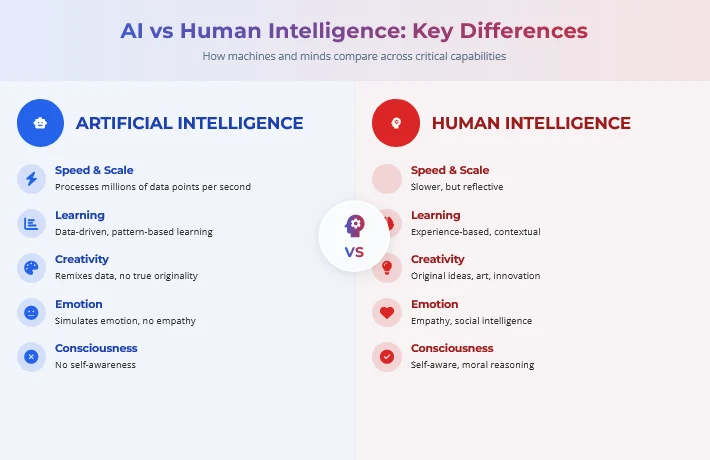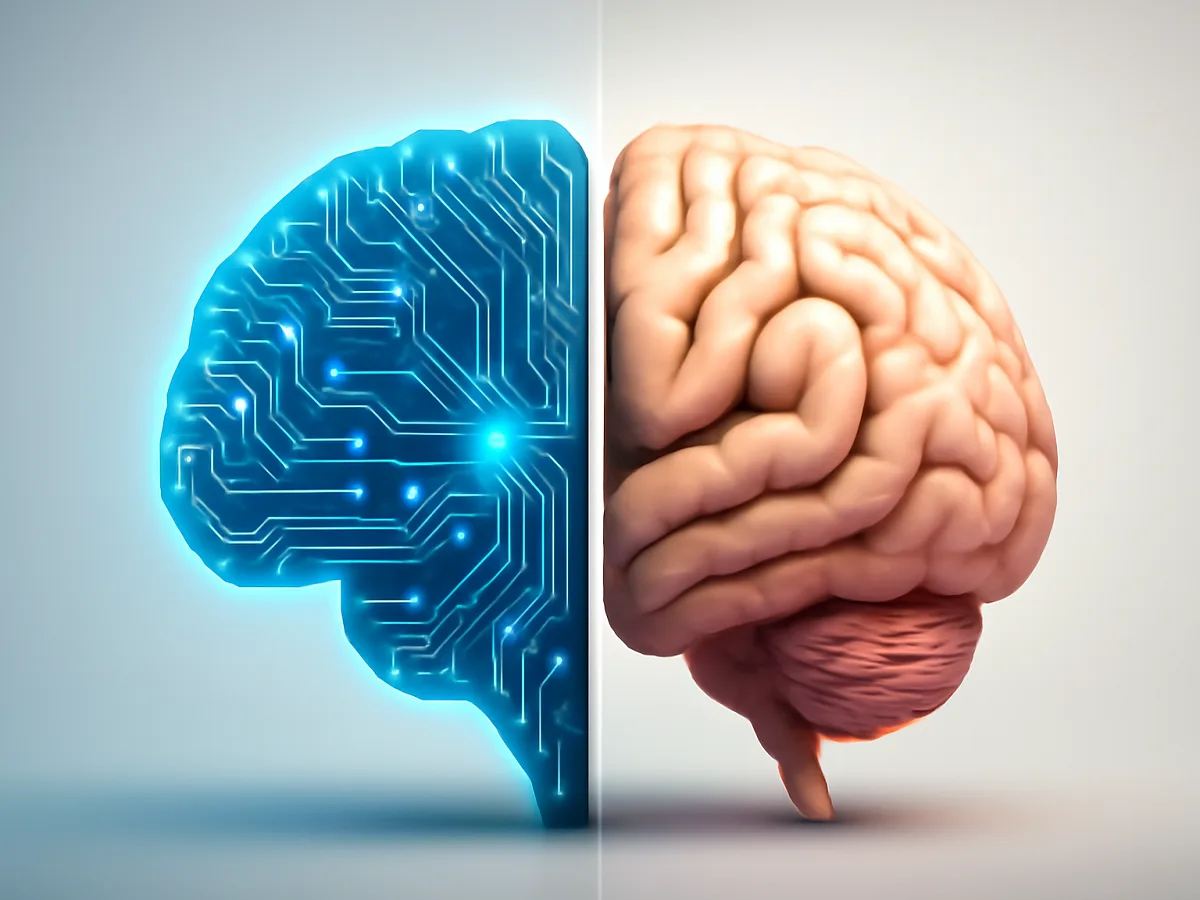Can AI think like a human? Not even close. It can process data at incredible speeds and uncover patterns that we often miss, but it’s missing the key elements of emotions and imagination. It’s also unable to make instinctive decisions.
Human intelligence comes from emotion, creativity, curiosity, and experience. AI simply follows code. We break rules, ask “why,” and adapt easily. Machines excel at speed and scale. We win at empathy, ethics, and original thought.
The real story isn’t about one replacing the other; it’s about how they work better together. The future is about collaboration. Doctors use AI to find diseases quickly. Artists tap into tools to inspire fresh ideas.
In this post, we’ll unpack the key differences, strengths, and real-world examples of AI and human intelligence side by side. No hype. Just straight talk on what each does best, and how the smartest future uses both.
What Is Artificial Intelligence?
Artificial Intelligence isn’t about robots taking over. It’s about machines learning tasks that need human thinking. Picture a system that gets smarter with each use. For example, Netflix might suggest a show you really enjoy. Or your phone could unlock the moment you look at it.
AI searches big data for trends and makes smart predictions. It focuses on one task at a time, like answering questions or spotting tumors.
It harnesses machine learning tools to level up, much like mastering a game. But let’s lay it bare: AI doesn’t truly “get it.” It doesn’t feel, ponder, or grasp meaning. It dances to the rhythm of patterns, not the melody of purpose. That’s our undeniable edge.
What Is Human Intelligence?
Human intelligence is more than book smarts. It helps us adapt, learn, and observe. Besides, it sharpens our instincts and helps us connect and overcome challenges.
Creativity, empathy, moral judgment, and curiosity shape our thinking. Unlike machines, we learn from just one experience. We link unrelated ideas and envision new futures. A child learns social cues by watching faces. An artist transforms pain into a song. A leader motivates a team during uncertainty.
Human intelligence is shaped by culture, personal experience, and memories. This makes it complex and unpredictable. However, it outshines AI in key areas: understanding meaning, building trust, and navigating our complex world.
AI vs Human Intelligence: Key Differences
Let’s be real—AI and human intelligence aren’t even playing the same game.

AI is like a calculator on steroids. It can sort through mountains of data while you’re still pouring your coffee. Need to scan 10,000 customer reviews in two minutes? AI’s already done it.
But ask it why a joke is funny, or how someone might feel after bad news- it’s clueless. It doesn’t get it. It just matches patterns.
Humans? We’re messy. We learn from tiny moments—a glance, a tone, a single failure that changes everything. We create because we feel, not because we were trained on billions of data points. Furthermore, we adapt fast, even when nothing makes sense.
Ever walked into a room and instantly knew something was “off”? That’s not logical. That’s intuition. AI can’t fake that.
Machines follow rules. We bend them, break them, and write new ones. AI wins on speed and scale. But we win on meaning, heart, and real-world smarts. One’s powerful. The other’s alive. And that difference? It matters.
Real-World Examples of AI and Human Collaboration
1. Doctors + AI
Hospitals use AI to scan medical images like MRIs and CT scans with high precision. AI finds tiny issues doctors might miss. But doctors review results, consider the patient’s story and feelings, and provide accurate and compassionate care.
2. Customer Support
You’ve seen it: chatbots answer “How do I reset my password?” in seconds. But when a customer is frustrated, confused, or needs an exception? The bot hands off to a real person. That agent listens, empathizes, and solves problems in ways no algorithm can. Result? Efficiency and empathy—best of both worlds.
3. Creative Work
Graphic designers harness the power of AI to conjure layout ideas and vibrant color palettes in a flash. Filmmakers embrace it to slice through editing tasks like butter. Yet, the vision, the message, and the emotional punch? Those are born from the human touch. AI handles the busywork while the creator breathes in the soul.
4. Teachers Using AI to Personalize Learning
Some schools use AI to track student progress. It flags those struggling with math or reading. But it’s the teacher who steps in. They provide encouragement, tailored explanations, or a simple “I believe in you” moment. AI sees the data, but the teacher sees the child.
5. Journalists & Researchers
Reporters use AI to scan thousands of documents in investigations. This includes leaked files and public records. The AI pulls out key names, dates, and patterns. But the journalist connects the dots, asks tough questions, and writes stories that inspire. AI handles the legwork, while humans provide truth and impact.
6. Emergency Response
AI models predict wildfires, floods, and disease outbreaks. They analyze weather, traffic, and social trends. Well! This data helps human heroes—firefighters, doctors, and coordinators. They make quick, crucial decisions to support communities during tough times.
The Future: Coexistence, Not Competition
The future isn’t some sci-fi movie where robots rise up and take over. That’s Hollywood drama. The real story is way more practical—and way more hopeful.
AI isn’t coming to steal your job. It’s coming to do the boring part of your job so you don’t have to.
Think about it: no one wakes up eager to sort spreadsheets, answer the same customer question again, or transcribe meeting notes. But AI can do those tasks quickly—and accurately.
That frees you up. To think, to create, and to talk to people like a person. Moreover, to use your gut, your experience, your heart.
Calculation tools arrived, accountants shifted to analysis. Computers emerged, writers produced better, faster work with more research.
The winners aren’t shying away from AI; they’re embracing it as a trusty co-pilot. Their focus? The uniquely human qualities that shine through: caring, connecting, leading, and discovering meaning amid the noise.
Because no matter how smart machines get, they’ll never miss a deadline because their kid was sick. They’ll never stay late to help a teammate. They’ll never look someone in the eye and say, “I’ve got you.”
That’s not tech. That’s human. And that’s what the future needs most.
Ethical and Societal Implications
When AI makes hiring or loan decisions, do you get a twinge? It’s like gazing into a sci-fi future, but this is our reality now. The questions start piling up like heavy boxes.
What happens to the guy who’s been driving a truck for 20 years when self-driving rigs take over the highway? Is he just… out of luck? Or do we help him learn something new? That’s not just about technology. It’s about fairness. About dignity.
Then there’s the scary part: AI getting things wrong in ways we don’t even notice. Like a resume screener that keeps passing over women because it was trained on old data where most hires were men. No one programmed it to be sexist. But it is, because it learned from our past mistakes. And now it repeats them—quietly, at scale.
Or think about your phone. It knows where you go, what you search, who you text at 2 a.m. Companies use AI to turn all that into predictions—what you’ll buy, how you’ll vote, even if you’re stressed. That’s powerful. And yeah, it’s kind of creepy. Who’s watching the watchers?
When life goes wrong, like a misdiagnosis or a loan denial, who helps? It’s not a “blame” button – humans take the fall. Here’s the thing: AI doesn’t wake up worried about right or wrong. It doesn’t feel guilt. It doesn’t care if someone loses their home. We do.
So the real challenge isn’t building smarter machines. It’s staying sharp, staying involved, and making sure we don’t hand over decisions that should stay in human hands. Not because we fear progress—but because some choices need empathy, context, and a pulse.
This isn’t just about rules and regulations. It’s about values. And that’s something no algorithm can teach us.
Final Thoughts
AI isn’t the enemy. It’s not the hero either. It’s a tool—powerful, fast, and always on. But it lacks heart, intuition, and moral judgment. Humans bring those. The future doesn’t belong to machines or people alone. It belongs to those who learn to work together. Stop fearing AI. Start mastering it.
The best outcomes happen when logic meets humanity.
Frequently Asked Questions (FAQs)
Here are true questions individuals ask about AI and human reasoning, replied to clearly and candidly.
Can AI ever be smarter than humans?
In speed and data crunching? Absolutely—it already is. But in understanding, creativity, and emotional depth? No. AI mimics intelligence; it doesn’t experience it. True “smarts” involve more than processing power—it’s about meaning, purpose, and connection.
Will AI replace human jobs?
AI handles routine tasks like data entry and customer service. Jobs needing empathy, creativity, and judgment are safe. So, embrace change.
Can AI think or feel?
AI doesn’t think like humans. It calculates and follows patterns, but doesn’t feel emotions.
Is artificial intelligence dangerous?
AI can be misused. Biased algorithms and automation can cause harm if not regulated.
What is the Turing Test?
Alan Turing’s test asks: Can a machine talk like a human? If it can, it passes. Some AI just imitates, without understanding.
Can humans and AI work together long-term?
Not just can—we already are. Doctors, teachers, artists, and engineers are using AI to do their jobs better. The strongest teams of the future won’t be humans or machines. They’ll be both.

